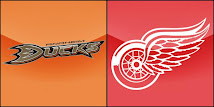
There needs to be a line drawn at some point on what is considered a head shot and what is not. The options are there, clearly. Either call them all equally or leave it alone. Tonight's game between Detroit and Anaheim, and the first game of the Chicago/Vancouver series have opened the door to even more signs of head shots but all the calls and fines have been wildly uneven.
Let us look back to Round 1. During the Calgary/Chicago series, Mike Cammalleri punched Martin Havlat in the face off a draw:
There was no penalty on the play, there was no suspension or fine handed out and the league claimed the event to be contained, non-violent and that Cammalleri has no history of violence.
Days prior, this event transpired during a game between the Pittsburgh Penguins and the Philadelphia Flyers - an event that lead to a suspension on Daniel Carcillo:
Carcillo was given a 1 game suspension for the act, and the Flyers head coach, John Stevens, was fined $10,000 because he had the tough guy on the ice during the last few seconds of play. Carcillo was acknowledged as a repeat offender but it does draw some odd lines in the subject.
Players who are not considered repeat offenders get away with a ton of acts, to the point that if they are not fined or suspended for any event they are still listed as "no history of violence". I think we can all remember this situation:
After the fact, the league ruled Chris Neil of having "no history of violence" and thus deemed the hit "legal". Neil, when talking to reporters, spoke proudly of his non-punishable hit and boasted the act. Then, during Game 6 between the Washington Capitals and the New York Rangers, this hit occurs:
What was so different between these hits? Both were late, both were high shots (elbow or not) and both resulting in significant injuries. There is a difference though, the league gave Donald Brashear a 5 game suspension for his hit on Blair Betts due to his "history of violence". Then, Game 1 of the Vancouver series rolls around and Ben Eager is out doing his normal thing - completing his checks and sparking his team:
Ben Eager did not get a penalty on the play, and was not suspended, but does have a history of violence. Then last night, the big hit occurs, Mike Brown hits Jiri Hudler on what is an obvious shot to the head:
There's two things about this hit that needs to be looked at. 1. Was it a bad hit? Yes, unfortunately, Hudler was watching his plan and did not see the hit coming.
2. Was it a late hit? No. If you watch the play and count the seconds it took from Hudler passing the puck to taking the impact, it's exactly 1 second. 3. Was it a high shot? No. Hudler was bent down when he took the hit, following through on the pass he had just got off his stick before taking the impact. Mike Brown was also bent low to bring the hit down to avoid making it a head on shoulder collision. If you watch the replays, Hudler is bent down so low that his head is level with Brown's chest.
It's an unfortunate play and people can rule all these hits as head shots, but the fact is that there is no rule in the rulebook that punishes hits to the head. Should there be? Technically there already is. You never see a guy get called for elbowing someone in the chest, only the head - head shot. You never see a guy get roughing for punching someone in the arm, only the head - head shot. So in an odd way, the rule does exist, but it is not listed in exactly a head shot format.
The only argument that should be made is that intent to injure should be called into question, which is of the referees decision. He ruled the hit to be a major and Brown was ejected from the game and given a 5 Minute Major. Technically, he has already served his punishment and thus a suspension is not in order. There is also the fine line of asking yourself "is every hit thrown in the game intent to injure?" Probably not, but if someone is out there hitting, he's out there to take the player out of the play and if he gets injured on a clean hit then it draws that question into play because the player throwing the hit meant to do so and meant to hit as hard as he had and thus the injury resulted from the impact thrown by the hitter.
But that is not how hockey works. The fact is, every single suspension is a discretionary call; some are fair, some are not. The history of violence can no longer be an excuse, but to consider every hit that results in an injury to be a punishable offense is wrong.
And just because players like Cammalleri are more talented than the Daniel Carcillo's of the game does not mean they should be treated differently. The league needs to treat every case fairly and make the judgment based on several factors:
Was it a late hit?
Was it intent to injure?
Was it clean - and if not, was it already dealt with on the ice?
In Mike Brown's case, it was dealt with.
Micheal A. Aldred
michealaldred@hotmail.com
Saturday, May 2, 2009
Hits To The Head: Not An Epidemic
Labels:
brown,
cammalleri,
carcillo,
cfb hockey,
cfbhockey,
checking from behind,
checkingfrombehind,
eager,
havlat,
head shots,
hudler,
micheal aldred,
neil,
rypien,
talbot
Subscribe to:
Post Comments (Atom)










No comments:
Post a Comment